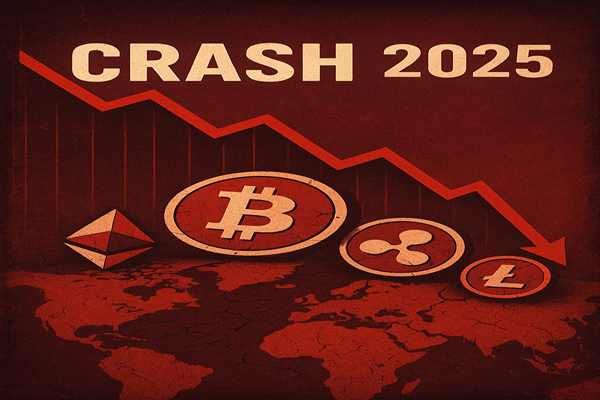Crypto Crash 2025: Did Thousands Commit Suicide After Bitcoin’s Biggest Fall?

Crypto Crash 2025: Did Thousands Commit Suicide After Bitcoin’s Biggest Fall?
Introduction
On October 10, 2025, the crypto world witnessed its darkest day — a day that sent shockwaves through every corner of the digital asset market. Within hours, billions of dollars vanished, portfolios turned to dust, and panic spread like wildfire.
Social media flooded with shocking claims — “Thousands of investors committed suicide after losing everything.”
But how much of it is true?
In this detailed report, we’ll break down what really happened during the Crypto Crash 2025, why Bitcoin and Ethereum plummeted, and whether there’s any truth behind the rumors of mass suicides.
We’ll also explore how AI-driven market predictions could have helped investors protect themselves — and how platforms like coin-predictions.com are shaping the future of safe crypto investing.
Current Market Overview
The crypto market has always been volatile, but October 10, 2025, marked an event that shook even the most seasoned investors.
On that day:
- Bitcoin plunged 8.4% to $104,782,
- Ethereum dropped 6.7%,
- Altcoins like Solana and Cardano crashed by 30% or more.
In total, the global crypto market lost over $19 billion in value — in just a few hours.
The trigger?
A surprising announcement by U.S. President Donald Trump, declaring a 100% tariff on Chinese technology exports.
This sudden policy decision sparked fear among investors, leading to a global sell-off across both traditional and digital markets.
What followed next was chaos — liquidation alerts, exchange outages, and mass panic.
Historical Price Trends
To understand the significance of the 2025 crash, let’s revisit Bitcoin’s previous downturns:
| Year | Event | Bitcoin Price Fall | Key Trigger |
|---|---|---|---|
| 2018 | ICO bubble burst | -84% | Market correction |
| 2020 | COVID-19 panic | -45% | Global lockdowns |
| 2022 | Terra Luna collapse | -60% | Stablecoin failure |
| 2025 | Trump Tariff Shock | -30% (in hours) | Global economic uncertainty |
Unlike previous crashes that unfolded over weeks or months, 2025’s meltdown occurred within hours — making it the fastest and most brutal correction in Bitcoin’s history.
The crash also marked the first time AI-based trading bots failed to predict such an immediate downturn.
Even sophisticated hedge fund algorithms couldn’t react fast enough to the human panic that followed Trump’s trade announcement.
Expert & AI Predictions
Before and after the crash, several AI models and crypto analysts made forecasts about the market trajectory.
🔹 AI Predictions (via platforms like Coin-Predictions.com)
AI-driven sentiment analysis tools had begun detecting growing tension in the global market by early October 2025.
Trade data, social signals, and volatility indices hinted at potential market turbulence — but not a collapse of this scale.
After the crash, AI tools quickly recalibrated, forecasting:
- Short-term recovery by November 2025
- Medium-term stabilization around $110,000–$115,000 for Bitcoin
- Long-term bullish trend for 2026, driven by halving and institutional adoption
Expert Opinions
Prominent crypto analysts like Michael Saylor and Cathie Wood described the crash as “a correction driven by macroeconomic fear, not by blockchain fundamentals.”
According to them, Bitcoin’s long-term trajectory remains intact, as the technology and adoption metrics continue to grow.
Key Factors Affecting the Crash
Let’s explore the main reasons behind this massive crash and investor panic.
1. Trump’s 100% Tariff on China
The political shockwave triggered a domino effect — fear of inflation, global supply chain stress, and investor flight from high-risk assets like crypto.
2. Mass Liquidations
Leveraged traders faced forced liquidations across major exchanges. Billions of dollars in futures positions were wiped out, accelerating the fall.
3. Psychological Panic
Social media played a huge role. Viral posts about “market collapse” and “suicides” created a self-reinforcing fear cycle.
4. Exchange Downtime
Popular platforms like Binance and Coinbase temporarily froze transactions during the peak volatility, leaving investors helpless.
5. Misinformation Spread
Unverified claims of “mass suicides” amplified market fear. In reality, only one confirmed death (Konstantin Galish) was officially reported.
The Tragic Death of Konstantin Galish
Amidst the chaos, a name that surfaced across global headlines was Konstantin Galish, also known online as Kostya Kudo — a 32-year-old Ukrainian crypto educator, YouTuber, and co-founder of Cryptology Academy.
Galish reportedly lost over $30 million during the crash.
A few days later, his body was found inside his Lamborghini near Kyiv.
Authorities confirmed it was a self-inflicted gunshot wound, with a legally registered firearm.
Investigators revealed that Galish had sent a farewell message to his family, expressing distress over financial losses and emotional exhaustion.
While there were rumors about extortion and business disputes, officials denied any foul play.
Galish’s death became a symbol of the mental and emotional toll of financial stress — a stark reminder that crypto volatility is not just about money, but also about human psychology.
Were There Really “Thousands of Suicides”?
Several Telegram and Reddit groups shared emotional posts claiming that “thousands” of investors had taken their own lives after losing their savings.
However:
- No official global data or verified reports support these claims.
- Only one confirmed case (Konstantin Galish) has been validated by authorities.
- Many posts were later found to be duplicate, exaggerated, or AI-generated panic content.
It’s safe to conclude that while many investors suffered immense losses and mental distress, the narrative of “mass suicides” is largely unverified misinformation.
The Human Cost of Crypto Volatility
The crash highlighted a deep, often ignored issue — mental health in the crypto world.
With markets operating 24/7, traders experience chronic anxiety, sleeplessness, and financial obsession.
Experts urge investors to:
- Diversify portfolios
- Set stop-losses
- Avoid emotional trading
- Seek professional or psychological help when overwhelmed
The Coin-Predictions.com team has consistently advocated for AI-assisted risk management, offering real-time data and emotional stability through predictive analytics.
Future Outlook (2025 and Beyond)
As the dust settles, the crypto market is already showing signs of recovery.
AI-based forecasts from Coin-Predictions.com suggest:
- Bitcoin will regain stability around $115,000–$125,000 by early 2026.
- Ethereum could rebound to $3,800–$4,200.
- Institutional interest will increase due to inflation hedging and blockchain adoption.
Meanwhile, governments may implement stricter investor protection laws and transparency requirements to curb speculative panic.
The long-term narrative remains strong:
Blockchain technology is here to stay — crashes are temporary, innovation is permanent.
FAQs (Top 10 Questions)
1. What caused the 2025 crypto crash?
The crash was triggered by Donald Trump’s 100% tariff announcement on Chinese tech exports, leading to panic selling.
2. Did thousands of people really commit suicide?
No verified data confirms this. Only one case (Konstantin Galish) was officially confirmed.
3. How much value did the crypto market lose?
Nearly $19 billion was wiped out in just a few hours on October 10, 2025.
4. What is Bitcoin’s lowest price after the crash?
Bitcoin dropped to $104,782, marking an 8.4% intraday fall.
5. How did AI models react to the crash?
AI trading bots initially failed to predict the crash but later adjusted with better volatility detection.
6. Who was Konstantin Galish?
A Ukrainian crypto educator and influencer who reportedly took his life after losing $30 million in the crash.
7. How can investors protect themselves from such crashes?
Use AI-powered analytics (like coin-predictions.com), diversify investments, and set realistic stop-loss targets.
8. What is the future prediction for Bitcoin in 2026?
AI projections indicate Bitcoin could rebound above $120,000 by mid-2026.
9. Is the crypto market safe now?
The market has stabilized, but volatility remains. Always invest cautiously and rely on credible AI-based forecasts.
10. Why choose Coin-Predictions.com for crypto insights?
Because we combine AI accuracy, expert research, and transparent forecasts to help you make smarter investment decisions.
Who, What, When, Where, Why, Which, Whose, How – Section Summary
- Who: Global crypto investors & influencer Konstantin Galish
- What: The biggest single-day crypto crash in Bitcoin history
- When: October 10, 2025
- Where: Worldwide (triggered by U.S.-China trade tensions)
- Why: Panic selling after Trump’s 100% tariff announcement
- Which: Bitcoin, Ethereum, Solana, Cardano — all affected
- Whose: Investors with leveraged positions suffered the most
- How: A combination of market psychology, liquidation, and misinformation
Why Choose Coin-Predictions.com
At coin-predictions.com, we don’t just follow the market — we forecast it.
Our AI-powered algorithms track thousands of real-time data points to:
- Predict price trends with high accuracy
- Warn about potential risks
- Suggest optimized entry and exit points
- Crypto Crash 2025
Whether you’re a beginner or a professional trader, our goal is to protect your portfolio before the storm hits.
Visit coin-predictions.com to get real-time AI predictions, expert crypto insights, and 24/7 market updates — before the next big move happens.
Final Words
The Crypto Crash of 2025 wasn’t just a financial event — it was a reminder of the thin line between profit and panic.
While rumors of “mass suicides” remain unverified, the tragedy of Konstantin Galish serves as a warning that mental health matters as much as market wealth.
As the crypto world evolves, AI and responsible investing will be the true keys to survival.
Stay informed. Stay calm. Stay ahead — with coin-predictions.com.




